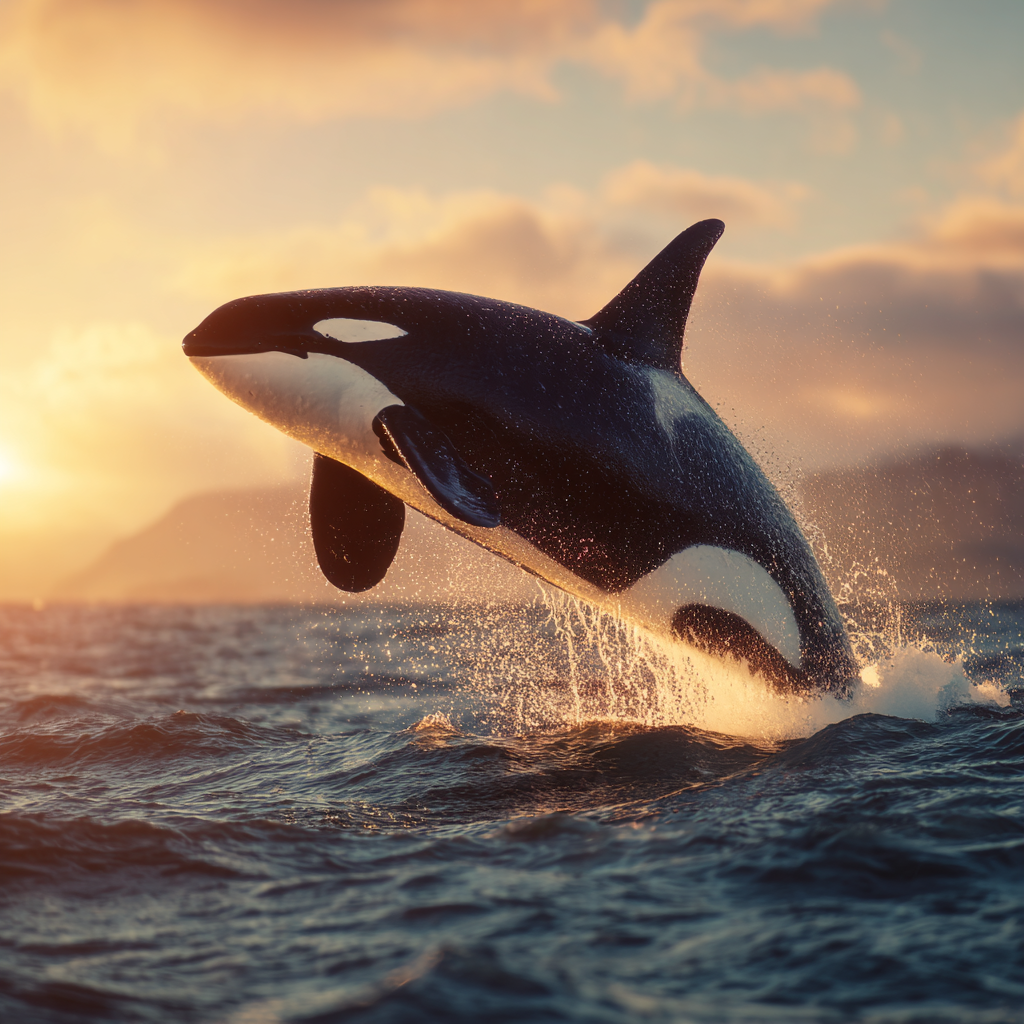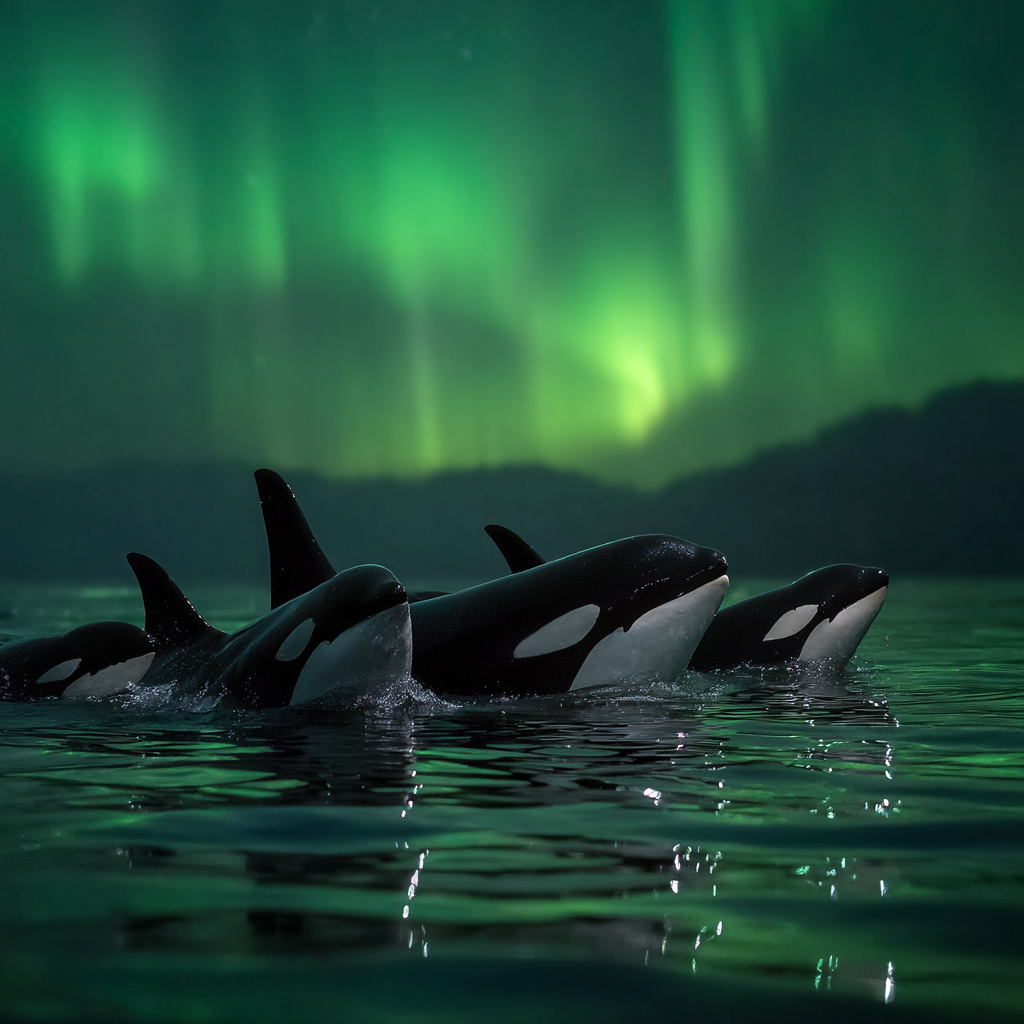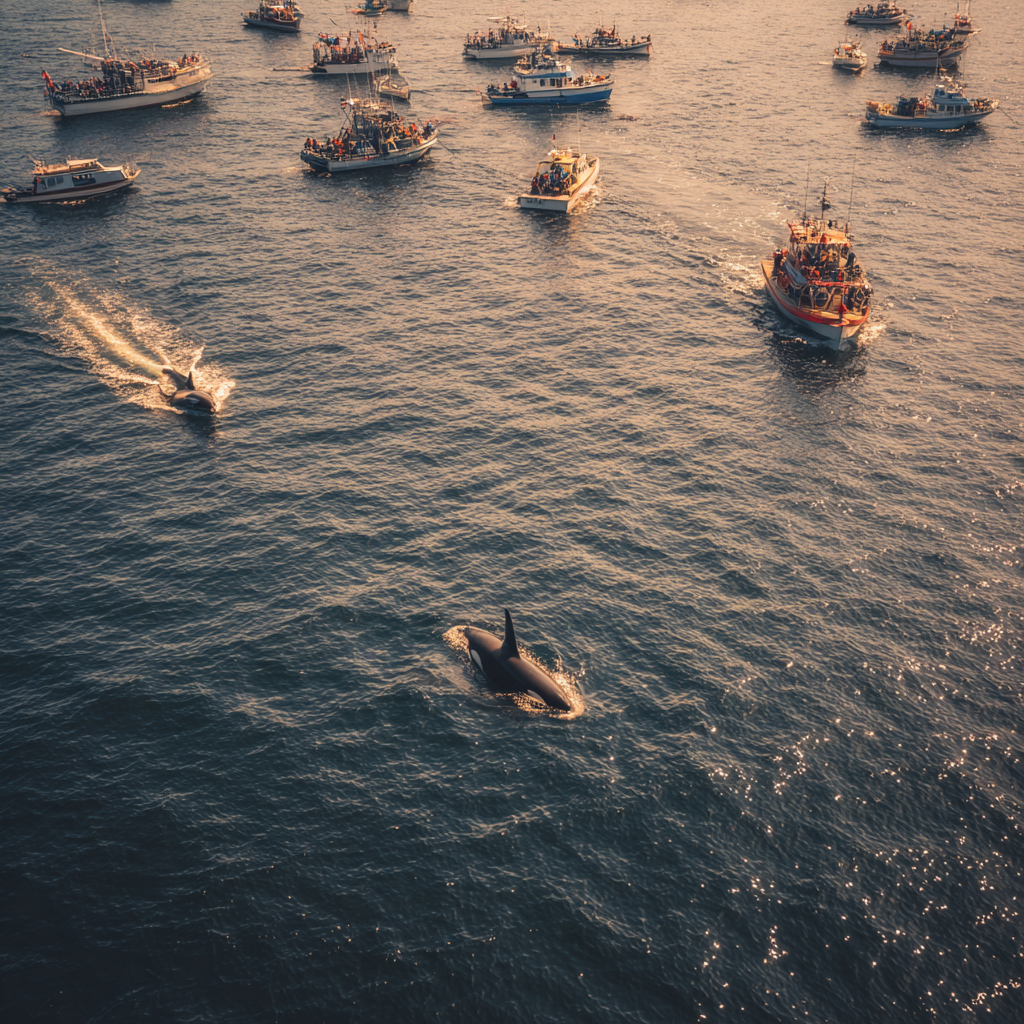Orca
Introduction: A Tale of Two Worlds
The Orca, or Killer Whale (Orcinus orca), is the ocean's apex predator, a position it holds not just through size and power, but through unparalleled intelligence, complex social structures, and sophisticated cultural traditions. It is a cosmopolitan species, found in every ocean, yet its populations are not monolithic. Instead, the orca exists as a collection of distinct ecotypes—parallel societies that inhabit the same waters but live in entirely different worlds, distinguished by their diet, dialects, and social customs.
This profound cultural diversity is mirrored in the human imagination, where the orca has been cast in dual roles: as a fearsome "killer" in one tradition, and as a powerful, respected relative in another. The name "killer whale" itself arose from ancient sailors' observations of these animals hunting large whales, though since the 1960s, the term "orca" has increasingly replaced this more ominous moniker in common usage.
This page explores the complex identity of the Orca, from its biological prowess and deep-seated cultural traditions to the myths that define its relationship with humanity.

A powerful orca glides through its ocean domain, displaying the distinctive black-and-white coloration and imposing dorsal fin that make this species unmistakable.
Biological Overview
Physical Characteristics
- Size: Males 6-8 meters (20-26 ft), up to 9.8 m; Females 5-7 meters (16-23 ft)
- Weight: Males over 6 tonnes; Females up to 5 tonnes
- Coloration: Unmistakable black-and-white pattern with white underside, eye patch, and gray saddle patch
- Distinctive Features: Largest dolphin family member; males have tall triangular dorsal fin up to 1.8 m (6 ft)
Life History
- Lifespan: Females 50-90 years; Males 30-50 years
- Sexual Maturity: Females 6-10 years; Males 10-13 years
- Gestation: 14-17 months
- Calving Interval: Every 6-10 years
- Calf Size at Birth: 2.4 meters (8 ft), 180 kg (400 lbs)
Distribution & Habitat
- Range: All major ocean basins worldwide
- Preferred Waters: Most common in coastal, temperate waters and areas of high marine productivity
- Distribution: From Arctic and Antarctic to tropical seas
- Population: Estimated ~50,000 worldwide
Diet & Hunting
- Trophic Level: Apex predator
- Diet Variation: Highly specialized by ecotype—fish, marine mammals, sharks, rays
- Hunting Strategy: Sophisticated cooperative techniques unique to each population
- Social Structure: Stable matrilineal family groups (pods)
A World of Many Cultures: Orca Ecotypes
The most remarkable aspect of orca biology is its division into distinct cultural groups known as ecotypes. These are not simply geographical variations but deeply ingrained, socially transmitted traditions that govern every aspect of their lives. Recent research suggests these ecotypes may represent separate species or subspecies. In the waters of the Pacific Northwest, three major ecotypes coexist but do not interact or interbreed:
Resident Orcas
Social Structure: Large, stable, multi-generational family groups (pods) centered around the eldest female. Matrilineal society where both sons and daughters remain with their mother for life.
Diet: Highly specialized fish-eaters, feeding almost exclusively on salmon, particularly Chinook salmon.
Vocalizations: Very vocal, using complex repertoires of clicks, whistles, and pulsed calls. Each pod has its own unique dialect passed down through generations, serving as a cultural badge of identity.
Behavior: Cooperative hunters that communicate constantly while foraging.
Bigg's Killer Whales (Transients)
Social Structure: Smaller, more fluid social groups compared to Residents.
Diet: Specialist hunters of marine mammals, including seals, sea lions, porpoises, and even the calves of large whales.
Vocalizations: Largely silent while hunting to avoid alerting intelligent prey. Dialects less complex than Residents, reflecting different social structure and hunting strategy.
Behavior: Use stealth and coordinated attacks to ambush prey. Named for Canadian scientist Michael Bigg who first described these differences.
Offshore Orcas
Social Structure: Live far from coast in large groups of 20-75 or more individuals.
Diet: Thought to consist primarily of fish, including sharks. Diet less well-studied due to their remote habitat.
Distinctiveness: Most enigmatic of the three ecotypes. Genetic analysis suggests they are distinct from the other two types.
Behavior: Rarely seen. Much remains unknown about their ecology and behavior.
Cultural Transmission: This division into ecotypes is a profound example of culture in a non-human species. The knowledge of what to eat, how to hunt it, and what dialect to speak is not innate—it is learned and passed down from mother to offspring, creating traditions that have persisted for thousands of years and have driven the evolution of these distinct, parallel societies.

An orca pod demonstrates the sophisticated cooperative hunting strategies that have made them the ocean's most successful apex predator.
Lords of the Undersea World: Pacific Northwest Mythology
For the Indigenous peoples of the Pacific Northwest Coast, the orca is not a "killer whale" but a powerful and respected being, often seen as the ruler of the undersea world and a symbol of strength and good fortune. In many traditions, orcas are believed to be the reincarnated souls of great chiefs or relatives who have passed away, living in complex societies in villages beneath the waves.
The Legend of Natsilane
A central story for the Tlingit people is the myth of Natsilane, a skilled hunter and master carver. The story tells of how Natsilane was abandoned on a remote island by his jealous brothers-in-law during a sea lion hunt. Alone and near death, he was rescued by the Sea Lion Chief, whose wounded son Natsilane had unknowingly speared during the hunt. In gratitude for healing his son, the Sea Lion Chief returned Natsilane safely to shore.
Seeking justice for his betrayal, Natsilane retreated to the forest with his carving tools. He carved a great whale from wood, trying first with spruce, then red cedar, then hemlock. Finally, using yellow cedar, he carved the first orca—the "Blackfish." Through powerful songs, he brought the carving to life.
He commanded the orca to find his brothers-in-law and destroy their canoe, but to spare their lives. The orca did as commanded. Then Natsilane gave the orca a sacred instruction: from that day forward, never harm a human again, but instead help them at sea.
The Sacred Pact: This myth establishes a sacred covenant between humans and orcas, framing the animal not as a threat, but as a powerful ally and a dispenser of justice, bound by ancient law not to harm the people with whom it shares the coast. Remarkably, there are no documented cases of wild orcas killing humans, a fact that resonates deeply with this ancient story.
In Tlingit, Haida, Kwakiutl, and other Northwest Coast cultures, the orca is revered in art, ceremony, and social structure. Orca images adorn totem poles, masks, and ceremonial regalia. Some tribes have orca clans, with the animal serving as a clan crest and spiritual protector. The orca represents not fear, but strength, family, protection, and the deep kinship between humans and the natural world.
A Fragile Apex: Conservation and Current Struggles
Taxonomic Uncertainty & Conservation Status
Global Status: Data Deficient (IUCN)
Reason: Profound taxonomic uncertainty—different ecotypes likely represent distinct species or subspecies
Reality: A single global assessment is meaningless; the true conservation story is one of specific, highly vulnerable populations facing severe threats
The global conservation status of the Orca is listed as "Data Deficient" by the IUCN, a designation that reflects the profound taxonomic uncertainty surrounding the species. It is highly likely that the different ecotypes are, in fact, distinct species or subspecies, each with its own unique conservation needs.
While the global population appears stable at around 50,000 individuals, specific populations face critical threats. The Southern Resident Killer Whales of the Pacific Northwest, for example, are listed as Endangered, with only about 75 individuals remaining. Other populations, such as the AT1 Transient population in Alaska and the Strait of Gibraltar population, are also severely threatened or depleted.
Current Threats
As apex predators, orcas face threats that cascade from the entire marine ecosystem:
Prey Depletion
Collapse of key prey species (particularly Chinook salmon for Resident populations) due to overfishing, habitat loss from dams, and climate change.
Chemical Contaminants
As apex predators, orcas accumulate extremely high levels of persistent pollutants (PCBs, DDT) in their blubber, impairing immune function and reproduction.
Vessel Traffic & Noise
Underwater noise from shipping and recreational vessels interferes with echolocation, communication, and hunting, causing chronic stress.
Climate Change
Ocean warming alters prey distribution and abundance, disrupting ancient hunting grounds and migration patterns established over millennia.

Despite their power and intelligence, orcas face mounting threats from human activities that degrade their ocean home and deplete their prey.
Synergistic Crisis: These threats create a deadly feedback loop. A starving whale is forced to metabolize its toxic blubber, releasing poisons into its system and further weakening it, all while struggling to hunt in a noisy, degraded environment. The plight of threatened orca populations is a stark reminder that even the ocean's most powerful predator is not immune to the consequences of ecosystem collapse.
References
- NOAA Fisheries. Killer Whale. https://www.fisheries.noaa.gov/species/killer-whale
- Morin, P.A., et al. Revised taxonomy of eastern North Pacific killer whales (Orcinus orca): Bigg's and resident ecotypes deserve species status. Royal Society Open Science. https://royalsocietypublishing.org/doi/10.1098/rsos.231368
- Whale & Dolphin Conservation USA. Orca (Killer Whale). https://us.whales.org/whales-dolphins/species-guide/orca-killer-whale/
- Wikipedia. Orca. https://en.wikipedia.org/wiki/Orca
- MarineBio. Orcas (Killer Whales), Orcinus orca. https://www.marinebio.org/species/orcas-killer-whales/orcinus-orca/
- Wikipedia. Natsilane. https://en.wikipedia.org/wiki/Natsilane
- Seabreeze Adventures. The first orca - Natsilane legend. https://www.seabreezeadventures.ca/post/the-first-orca
- Native Languages. Native American Indian Killer Whale Legends, Meaning and Symbolism. http://www.native-languages.org/killer-whale.htm